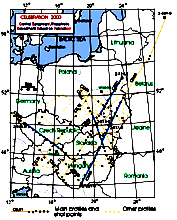
Central Europe contains a diversity of interesting and important geological features, extending across Europe from the British Isles to the Black Sea region. The region boasts a long and complex history of major tectonic activity, the origin and nature of which pose many challenging questions to scientists.
In an ambitious collaborative research effort to investigate the deep structure and evolution of the important tectonic features in Central Europe, Principal Investigator Dr. G. Randy Keller from the University of Texas at El Paso joined with a number of international colleagues to undertake "CELEBRATION 2000: A Seismic Investigation of Lithospheric Structure in the Trans-European Suture/Carpathian Mountains Region". This NSF-funded effort was led by researchers from the geophysical and geological communities in the US, Poland, the Slovak Republic, Hungary, the Czech Republic, Russia, Austria and Denmark, with team members from Canada, Germany, Finland, Belarus and Sweden also contributing to the project.
The project focuses on investigating and delineating geological features in several key areas: the Trans-European suture zone (TESZ) region, the southwestern portion of the East European craton (continental plate) in southern Baltica, the Carpathian Mountains, the Pannonian basin, and the Bohemian massif (see map).
Working with his colleagues from the Institute of Geophysics of the Polish Academy of Sciences, the University of Warsaw, the Eotvos Lorand Geophysical Institute in Budapest, the Slovak Geological Survey, the Institute of Geophysics in Bratislava (Slovakia) and the Geophysical Institute in Prague (Czech Republic), Dr. Keller helped lead a team of over 500 individuals in a data acquisition effort of huge proportions, using an extensive network of over 1,100 seismic data-gathering stations deployed along profiles that exceeded 8,900 km in length.
The logistics of coordinating a data-gathering operation of this magnitude are in themselves daunting. First, the huge geographic study area must be divided into manageable areas of responsiblity. Certain people are put in charge of detonating the seismic sources, which in effect will send sound waves bouncing around down in the earth. Another group of people are entrusted with placing hundreds of instruments in precisely arranged locations.
"As one of my Polish colleagues put it, it really comes down to a great many people who each have their own smaller experiment to do," explains Dr. Keller. "Once you have it all organized up front, everyone is responsible for doing their part. If they do it when and where they're supposed to, then it all comes together."
Ultimately, it all comes down to timing. Milliseconds, to be exact.
To ensure that everything happens at precisely the right time, in precisely the right place, the entire experiment is coordinated to GPS time using the Global Positioning System (GPS). All the recording instruments are set to GPS time, and the "shots" sent out by the detonation devices are fired to GPS time. The GPS is also used at the outset, to locate all of the sources and receiver locations that will be used in the experiment.
In the case of CELEBRATION 2000, the colossal effort paid off. Over 95% of the instrumentation returned useful seismic data that, combined, dwarfs all previous efforts in the region. Interpreting such a quantity of data is another herculean task, which is being accomplished via a collaborative effort in universities all over the world. Eventually, the data will allow researchers to produce 2-D and 3-D models of the earth's crust and upper mantle in the areas surveyed.
"It is a dataset unlike any other in the world," Dr. Keller says. "It will enable us to see how the Central European continent was formed, and examine the interesting boundary between eastern and western Europe, and delineate the building blocks of it, which would never have been possible before."
Certainly the geologic interest of Central Europe stands on it's own, but according to Dr. Keller, a meaningful analogy can be drawn to eastern North American. In essence, the geological boundary between eastern and western Europe bears a strong resemblance to the Appalachian Mountains in the U.S., which act as a boundary between the core of ancient North America and its relatively "new" elements ("new" in the geologic sense -- 300 million years old).
In addition to gleaning invaluable information about the geodynamics of Central Europe, Dr. Keller's NSF-funded efforts have helped foster an unprecedented international collaboration between leading experts in the U.S. and Central/Eastern Europe.
"It's been a great symbiotic relationship, and we have to share the credit with everyone involved," Dr. Keller says. "When it comes to providing instrumentation, and looking at the bigger geologic issues before and after the fact, the U.S. tends to take the lead. But Aleksander Guterch in Poland is really the master organizer of these big efforts at this point. And when it comes to breaking the dataset down into individual profiles and geologic targets, and analyzing it, we all participate equally."
CELEBRATION builds on an earlier NSF-funded collaboration begun in 1997 in which Dr. Keller and his colleagues joined researchers from Poland in a very large seismic experiment entitled POLONAISE '97 that targeted the northern portion of the TESZ region. That project was also very successful, resulting in a number of scientific papers for major journals. Dr. Keller's more recent projects, ALP 2002 and SUDETES 2003, are a continuation of the CELEBRATION effort.
This research project is supported by the Central and Eastern Europe Program.
For more information, please see:
ALP 2002 website
http://www.alp2002.infoCELEBRATION 2000 website
http://paces.geo.utep.edu/celebration.shtmlPOLONAISE'97 website
http://paces.geo.utep.edu/polonaise.shtmlDr. G. Randy Keller
http://www.geo.utep.edu/Faculty_Staff/keller.html
Posted: January 31, 2003
|
|



